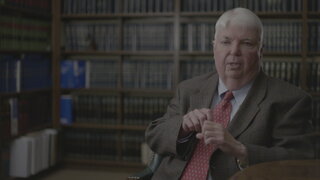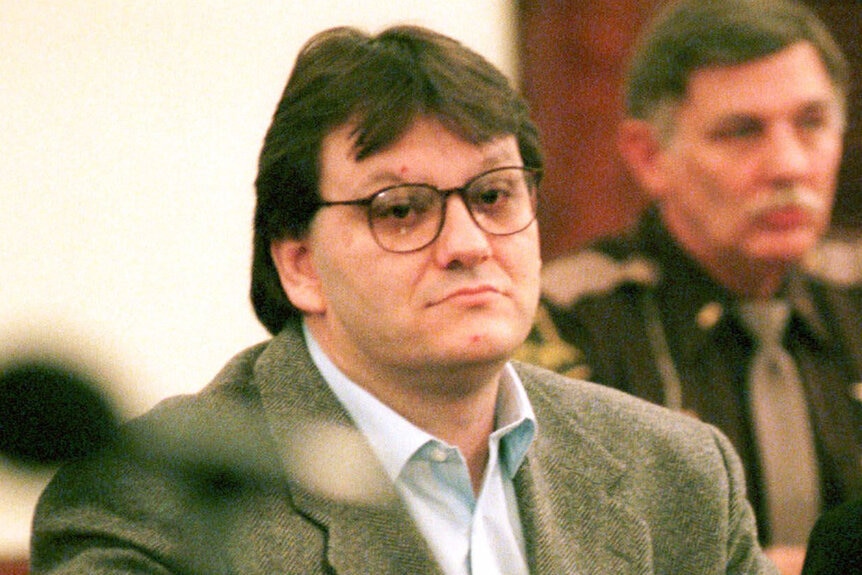Create a free profile to get unlimited access to exclusive videos, breaking news, sweepstakes, and more!
‘Angel Of Death’ May Have Given Lethal Injections To More Than 130 As A Nurse
So many patients died under the care a Clinton, Indiana, nurse that co-workers began to joke that he was the “Angel of Death.” The lethal care Orville Lynn Majors gave to patients was no laughing matter, though, and he was eventually convicted of murder.

Murders A-Z is a collection of true crime stories that take an in-depth look at both little-known and infamous murders throughout history.
Vermillion County Hospital in Clinton, Indiana, saw a dramatic uptick in deaths in the early 1990s. Most of those who died were elderly patients in the intensive care unit. While ICU deaths usually topped out around 20 or 30 a year, by 1994 they had skyrocketed to more than 100.
The hospital’s staff was at a loss to explain why more people were dying more frequently. Soon, they began to see a pattern in the deaths, however. People seemed to die whenever Orville Lynn Majors was working. It became so obvious that fellow nurses began referring to him as “The Angel of Death.” And, although Majors was eventually brought to justice, it is still unknown how many victims fell prey to his lethal injections of heart-stopping drugs.
Orville Lynn Majors was born in 1961 in Linton, Indiana, a small town just south of Terre Haute, not far from the Illinois border. He was the son of a coal miner, and was inspired to become a nurse after taking care of his ailing grandmother as a teenager. "He was like a big teddy bear. He was a very likable guy who was always laughing and making people feel better," high school friend Amy McCombs told the Chicago Tribune.
In 1989, after graduating from the Nashville Memorial School of Practical Nursing, Majors moved back to Indiana and began working at Vermillion County Hospital in Clinton, 50 miles north of his hometown. He worked there until 1991, when he took another job in Tennessee. In 1993, he returned to Vermillion, where he received glowing work evaluations, according to People magazine. He became one of the most popular nurses in the 56-bed facility. "He seemed so caring and concerned," Dom Rolando told the Chicago Tribune. Rolando’s 79-year-old sister would be one of many who died on Majors’ watch.
The deaths in the small, four-bed ICU unit started to rise soon after Majors came back to the hospital in 1993. While admissions held steady, in 1994 the mortality rate jumped to 100 — nearly four times the previous year’s, according to court documents.
While the victims were elderly, the circumstances of their deaths didn’t make sense. Patients died from conditions they didn’t have when they were admitted, or took a rapid turn for the worse, despite first being in comparatively good health. Many of the deaths followed an odd pattern: Respiratory arrest followed by an erratic heartbeat, which was the opposite of the usual order of things, according to the Los Angeles Times.
A study commissioned by state prosecutors would later determine that a death occurred nearly every 23 hours when Majors was on duty, according to the Los Angeles Times. When he wasn’t at work, the rate dropped to one death every 551 hours. Vermillion County Prosecutor Mark A. Greenwell told the Chicago Tribune that the likelihood of someone dying was 42 times greater under Majors’ care.
“At one point, there was a week where the deaths suddenly plummeted back to normal,” cardiac specialist Dr. Eric Prystowsky was quoted in People magazine. “Guess who was on vacation that week? Mr. Majors.”
Gradually, Majors’ co-workers began to notice the correlation between when he was at work and when people died. Nurses on the night shift even joked about it and took bets on which patient would die during his next shift, according to the Los Angeles Times. When Majors' schedule moved to weekends, "the deaths followed him accordingly," according to the affidavit for his arrest.
Other rumors also began to circulate, which may explain Majors’ mindset and motivations. The affidavit for his arrest indicated that those who knew him noticed a change in his personality after he returned to Vermillion. He was irritable and easily offended. One friend told police that Majors had begun shooting up methamphetamines and carried a bag of fresh syringes with him, according to the Los Angeles Times. Majors allegedly hated old people, saying “they should all be gassed,” and called the families of those he looked after “white trash” and “dirt,” according to the Associated Press.
Majors killed his victims by injecting them with potassium chloride or epinephrine, both of which can stop the heart at high dosage levels. In April 1994, Majors was observed sticking a syringe into 80-year-old Dorothea Hixon's IV. He then kissed her on the forehead, and said, “It's all right, punkin. Everything is going to be all right now,” according to the Washington Post. 60 seconds later she was dead.
Russell Firestone Jr. told the Los Angeles Times that he saw Majors inject his 73-year-old father with an unknown substance. When he asked what it was, Majors left the room. Moments later, he returned and said, “Who do you need to call? Your dad’s dead.”
Alarmed by the high mortality rate at the hospital, Nursing Supervisor Dawn Stirek pulled employee time cards to see who was working at the times of the deaths. She found that Majors had been on duty during 130 of 147 deaths from May 1993 to March 1995, according to The New York Times. Later that year, the State Nursing Board revoked Majors' license for five years for practicing beyond his authority by giving emergency drugs and working in an intensive-care unit without a doctor, according to The New York Times.
In September 1995, the Washington Post reported that the first of 15 bodies had been exhumed to test for potassium chloride poisoning. Over the next two and a half years the Indiana State Police spent $1.6 million dollars investigating Majors, according to the Chicago Tribune. A search of his home and vehicles would later produce physical evidence, including syringes, drug vials filled with potassium chloride and empty boxes labeled "epinephrine." Majors, meanwhile, ran a pet store back home in Linton, and appeared on daytime talk shows, including “The Montel Williams Show” and “Donahue,” to proclaim his innocence.
On Dec. 29, 1997, after a 33-month investigation, Indiana State Police arrested Orville Lynn Majors and charged him with six counts of murder, according to the Associated Press. Following his arrest, he was held without bail. Despite the evidence against him, he still had his defenders in the local community. "I can't say whether he did it or not, but I can tell you this: I know a lot of my elderly clients say he was the best nurse they ever had and they just can't believe he's guilty," Clinton area hairdresser Martha Roskovensky told the Chicago Tribune.
Following a five-week trial in fall 1999, Orville Lynn Majors was found guilty on six counts of murder. The jury heard testimony from 79 witnesses, including 23 doctors, according to the Los Angeles Times. In November 1999, Majors was sentenced to 360 years in prison — 60 for each count of murder. With his conviction, he became the most prolific killer in Indiana prison system, according to CBS News.
In the aftermath of the trial, the families of numerous patients who died at Vermillion County Hospital during Majors’ tenure filed wrongful-death lawsuits, and the facility was fined $80,000 by the state for negligence and code violations, according to The New York Times. In 2009, Indiana’s Tribune-Star newspaper reported it had changed its name again to Union Hospital Clinton.
In prison, Majors quietly maintained his innocence, while refusing all interview requests. He was considered a model prisoner, with a minimum of infractions and held several jobs, according to the Indianapolis Star. On Sept. 24, 2017, Majors began having trouble breathing and later became unresponsive at the Indiana State Prison at Michigan City. He was pronounced dead later that afternoon at age 56, according to the Tribune-Star. The cause of death was listed as heart failure.


















